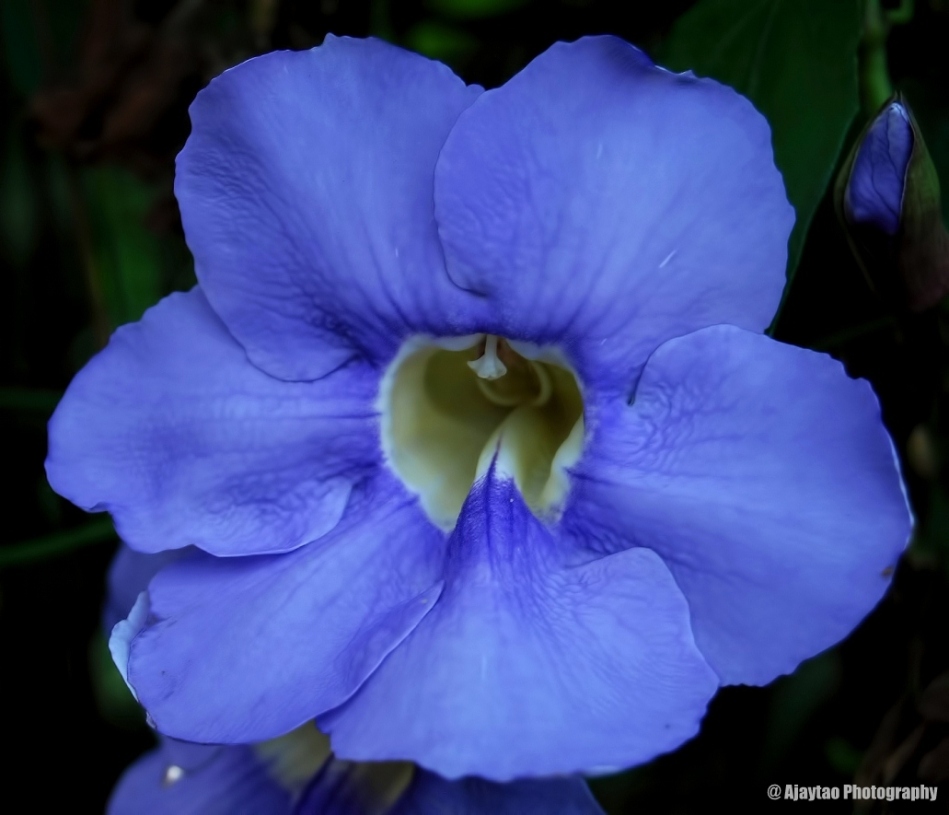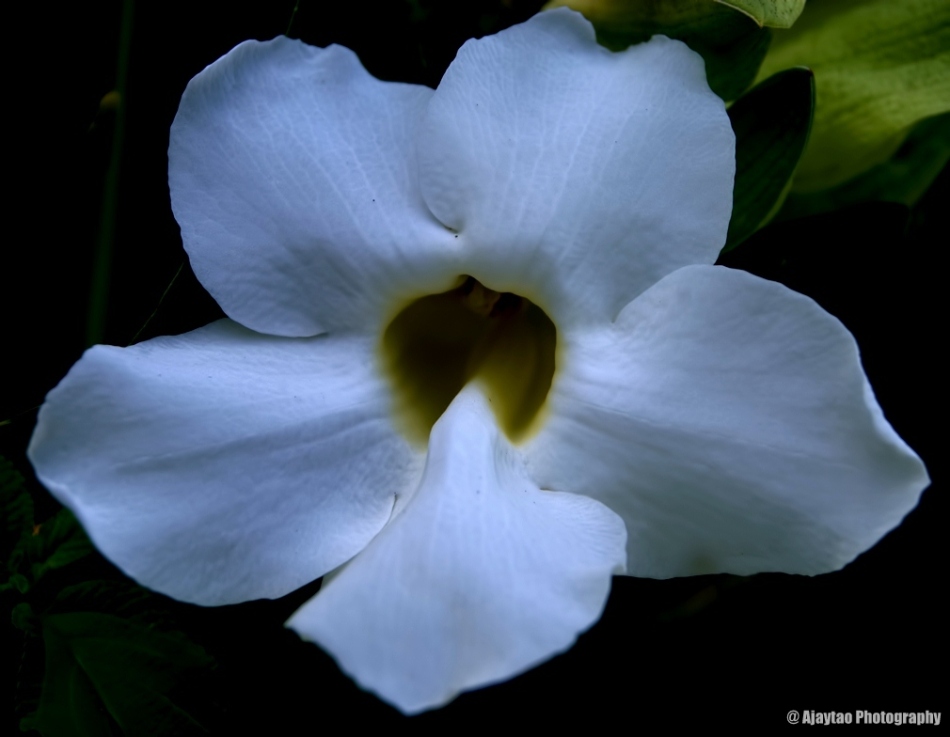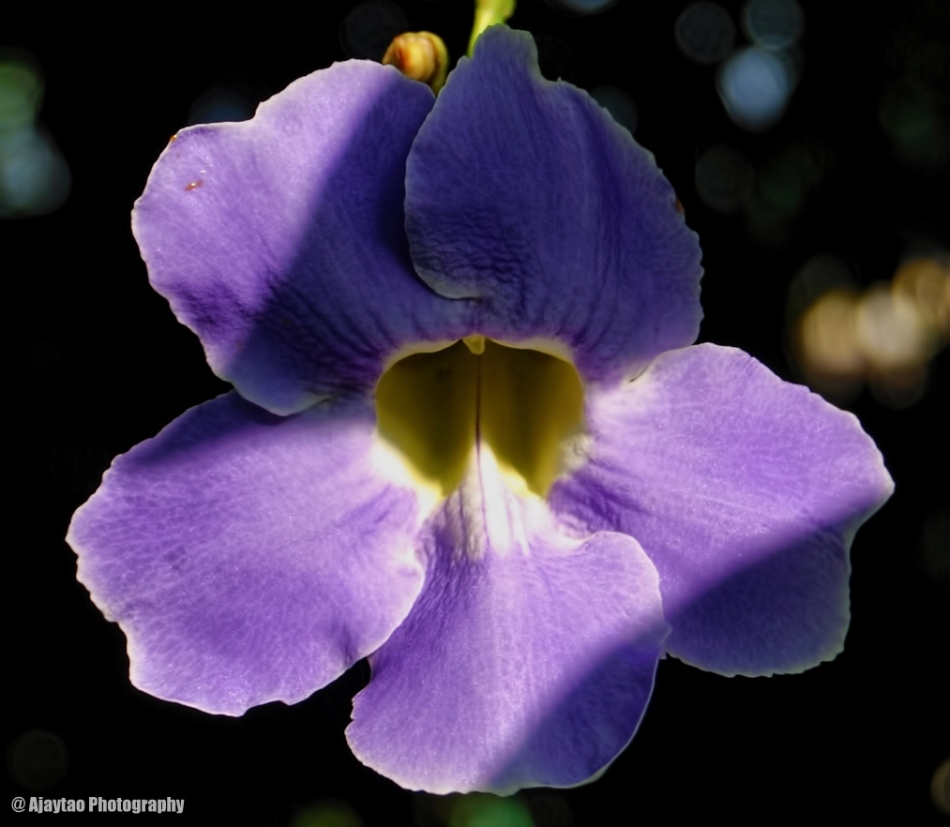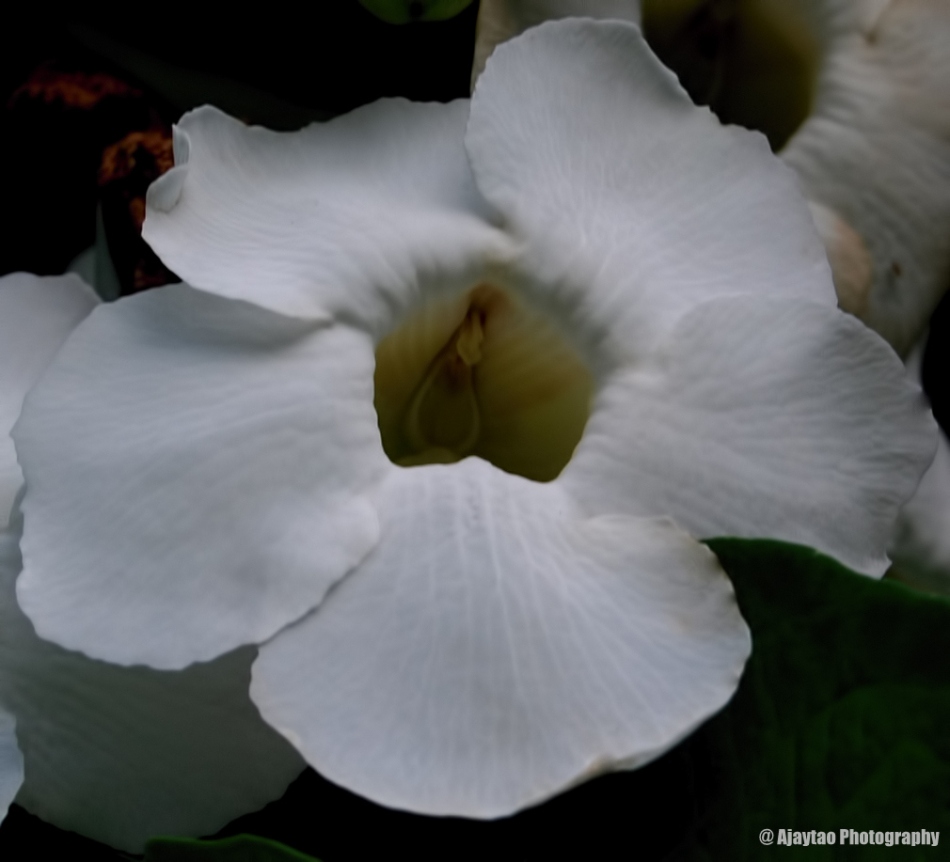Thunbergia Grandiflora – Bengal clock vine – Ajaytao
Common name: Bengal Clock Vine, Bengal Trumpet Vine, Blue Sky Flower, Blue Sky Vine, Blue Trumpet Vine, Sky flower, Blue thunbergia, Blue trumpetvine, Large-flowered Thunbergia, Laurel-leaved Thunbergia, Laurel Clock Vine, Babbler’s Vine (Akar Tuau in Malaysia).
Hindi: नील लता Neel lata • Hindi: नील लता Neel lata • Bengali: নীল লতা Neel lota • Assamese: Kukua loti • Mizo: Vakohrui, Zawngafian, Vako • Khasi: Jermi khnong, Syntiew jyrni chankhlaw
Botanical name: Thunbergia grandiflora, T. grandiflora ‘Alba’ (with white flowers), T. grandiflora ‘Augusta Blue’ (with sky-blue flowers)
Family: Acanthaceae (Barleria family), (Acanthus family)
Genus: Thunbergia Retz. – thunbergia
Species: Thunbergia grandiflora Roxb
Kingdom: Plantae – Plants
Subkingdom: Tracheobionta (Vascular plants)
Order: Scrophulariales
From a distance, this twining, flowering vine looks like a morning glory and even up close the flowers are quite similar. The Bengal Clock Vine has been called by some “the most beautiful vine in the world”. The curious name clock vine comes from the fact that it twines around a support in a clockwise direction. The name for the genus honors the Swedish naturalist Carl Peter Thunbergia (1743-1828) who was a student of Linnaeus and spent several years botanizing the Cape of Good Hope.
The specific epithet is from the Latin words ‘grandis’ meaning “great” or “large” and ‘flora’ meaning “flower” in reference to the flowers which are large for the genus. Another common name for this plant is Bengal Clock Vine. This description is based on our research and observations of this plant as it grows in containers at our nursery, in our own garden and in other gardens.
Climbing shrub, herbaceous or woody, thick and strong, reaching 8m. Branch densely covered with short soft hairs early, slightly 4 ridged, later gradually turning round, densely covered with short soft hairs early, with black nested glands and sparse long hairs below master node. From the rope-like stems, that can reach to the top of large structure or even cover a good sized tree, emerge the dark green leaves that are leathery and have a distinctive elongated heart shape, 4-5 inches long and often have a slightly toothed margin. The leaves are green, heart-shaped, and variably angled or lobed with large, pointed lobes. A vigorous evergreen vine with rope-like stems.
It bears wide flowers that are generally sky-blue or lavender-blue. Some varieties (E.g. ‘Alba’) have pure white flowers. Thunbergia grandiflora 3 inch wide pale blue or white flowers are cup-like with pale yellow to cream blue striped centers. From mid-summer to fall appear the beautiful 3 inch wide, Pale blue, Light Blue/ Violet/ Lavender/ White/ Near White, tubular flaring flowers that are cup-like with pale yellow to cream blue striped centers. The tubular flowers of the skyflower vine are a little deeper, about 3 in (7.6 cm) long, and are borne in drooping clusters. The most commonly seen varieties are sky blue to light violet although there is a white flowered type as well.
It is one of the most free flowering vines for shade in the South and is underused due to lack of distribution. Growth slows or stops in cool temperatures, and the top is killed to the ground after a freeze. In frost free climates, it is evergreen.
This plant can climb high and wide onto supporting structures or trees. Plant in full sun or in a shaded location (this vine will find the sun!). Can be watered regularly to only occasionally. It is hardy and evergreen to 25° F and if frozen to the ground (as it was here in our very cold December 1990 at 18° F) it can resprout and grow into a large vine within one season.
Thunbergia favors quite rich, organic soil and requires structural support. It may need to be cut back often to control direction or size or allow it to roam free if you have the space. This plant can be in bloom at nearly any time of year but will sulk during cold months.
Duration: Perennial, Evergreen
Growth Habit: Vine
Evergreen: Yes
Flower Color: Light Blue/Violet/Lavender/White/Near White
Bloom time: Spring/Fall
Height: Climbing (Vine)
Width: Spreading
Exposure: Sun or Shade
Moisture: Moderately moist
Irrigation: (H2O Info): Medium Water Needs
Winter Hardiness: 25-30° F
Hardiness: USDA Zones 8-11.
Propagation: Very easy to propagate from cuttings in warm weather.
This vine is native to Southeastern Asia, and more precisely to India.
This plant naturally ranges from China (Fujian, Guangdong, Guangxi, Hainan, Yunnan) Myanmar, Thailand and Vietnam but has also naturalized in tropical regions worldwide.
Harvest & Processing Roots: excavated in summer and autumn, washed, sliced, and used fresh or sundried. Stem leaves: harvested in summer and autumn, chopped into segments, used fresh or sundried.
Outdoors as a perennial, plant alongside cannas, interspersed with ferns and hostas, or near a water feature. Use as a house plant in zones where the ground freezes. Bengal clock vine is an easy to care for plant that can quickly cover a fence or pergola.
Root: taste pungent, neutral in nature. Stem leaves: taste pungent, little bitter, neutral in nature. Roots: dispelling wind and freeing the network vessels, dispersing stasis for suppressing pains. Stem leaves: promoting blood circulation for suppressing pains, removing toxin for detumescence.
Uses: Medical part: roots and stem leaves.
Chinese name: roots: Tongguxiaogen. Stem leaves: Tongguxiaojingye.
Chemistry: Flowers contain flavonoid: apigenin 7-glucuronide, luteolin, luteolin 7-glucoside and malvidin-3, 5-diglucoside and stilbericoside. The novel iridoid glycosides, isounedoside and grandifloric acid, were isolated from Thunbergia grandiflora. Grandifloric acid contains C-10 as a carboxylic acid group, the presence of which was predicted by recent iridoid biosynthesis studies carried out within T. alata. Isounedoside contains a rare 6,7-epoxide functional group. A revision in some of the NMR spectral assignments for the known iridoid glycoside alatoside was also made.
Medicinal uses:
Root: used for rheumatic arthralgia, algomenorrhea, swelling pains caused by falls, fractures, sequelae of infantile paralysis. Stem leaves: used for injuries caused by falls, fractures, sores and furuncles, snake bites. Roots: oral administration: decocting, 15-30g. External application: appropriate amount, fresh products smashed for applying or decocted for washing affected parts. Stem leaves: oral administration: decocting, 9-15g.
Leaves are used as a poultice in stomach complaints. Watered down sap of the stem is used to treat eye diseases in Chittagong Hill Tracts. Sap blown from the stem is given in eye pain; it has some cooling effect in the eyes (Marma). Leaves are used to treat stone in urinary bladder and elephantiasis in Khagrachari.
Disregarding its weedy nature, this beautiful Thunbergia laurifolia has medicinal benefits too. It is widely used as a traditional medicine, especially in Thailand, Malaysia and India. The leaf sap is used for menorrhagia, ear infections and deafness, and the poulticed leaves to soothe cuts and boils. Leaves are also used as an antipyretic agent and antidote for scorpion venom and dried leaves as a herbal tea to treat drug and alcohol abuse. Besides, it has antioxidant, antibacterial, antifungal, anti-inflammatory and antitoxic properties.
Warnings
The species has become a serious environmental weed in Australia on disturbed land along watercourses and in the wet tropics where it smothers other vegetation. It is commonly seen north of Sydney where it has been cultivated for many years.
Ajaytao Photography
This entry was posted on May 27, 2014 by Ajaytao2010. It was filed under Flowers and was tagged with (Acanthus family), Ajaytao, Ajaytao Photography, Assamese: Kukua loti, Babbler’s Vine (Akar Tuau in Malaysia)., Beautiful, Bengal clock vine, Bengal Trumpet Vine, Bengali: নীল লতা Neel lota, Blue Sky Flower, Blue Sky Vine, Blue thunbergia, Blue Trumpet Vine, Blue trumpetvine, Botanical, Botanical name: Thunbergia grandiflora, Botany, Colorful Flowers, Family: Acanthaceae (Barleria family), Flowers, Gardens, Genus: Thunbergia Retz. – thunbergia, Hindi: नील लता Neel lata, Hues of Nature, Large-flowered Thunbergia, Laurel Clock Vine, Laurel-leaved Thunbergia, Macro Photography, Mizo: Vakohrui, Nature, Nature Photography, Natures Beauty, Plants, Shades of Nature, Shrubs, Sky flower, Species: Thunbergia grandiflora Roxb, T. grandiflora 'Alba' (with white flowers), T. grandiflora 'Augusta Blue' (with sky-blue flowers), Thunbergia Grandiflora, Vako, Zawngafian.






Beautiful post Ajay, best wishes, my fellow blogger,
Aquileana 😛
LikeLike
May 27, 2014 at 1:04 am
Thank you so much dear 🙂
really i thank you from my heart 🙂
LikeLike
May 27, 2014 at 1:08 am
beautiful, Ajay!
LikeLike
May 27, 2014 at 2:37 am
thank you so much dear 🙂
LikeLike
May 27, 2014 at 8:16 am
Much beautiful! I like!
LikeLike
May 27, 2014 at 12:49 pm
Oooooh …thank you so much dear 🙂
LikeLike
May 27, 2014 at 1:04 pm
It’s so pretty. I take it to paint. O. K. ?
LikeLike
May 27, 2014 at 1:14 pm
Yes yes dear absolutely okay dear Maria 🙂
I would love to see that 🙂
Thank you so much 🙂
LikeLike
May 27, 2014 at 1:20 pm
It’s right, When I’ll paint it, you see it. Love, my dear Ajay
LikeLike
May 27, 2014 at 1:23 pm
Thank you soooo much dear Maria 🙂
Love and hugs Ajay 🙂
LikeLike
May 27, 2014 at 1:25 pm
:))
LikeLike
May 27, 2014 at 1:27 pm
🙂 🙂
LikeLike
May 27, 2014 at 1:28 pm
Hermosas!
LikeLike
June 4, 2014 at 8:57 am
Oh thank you so much dear 🙂
LikeLike
June 4, 2014 at 9:04 am
Reblogged this on Ajaytao 2010 and commented:
Thunbergia Grandiflora – Bengal clock vine – Ajaytao
LikeLike
June 6, 2014 at 1:07 pm